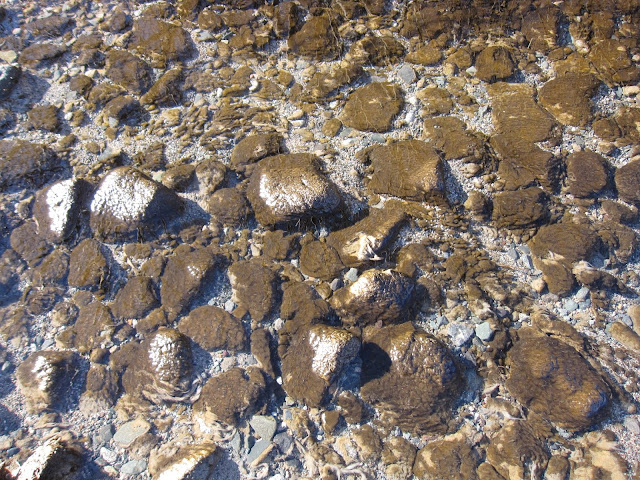The Spread of Didymosphenia geminata
 |
| Micrograph of D. geminata cell (Spaulding, 2010) |
Several species of the diatom
genus, Didymosphenia, have been
identified, however one species in particular stands out among the others. D. geminata, commonly called ‘didymo’ or
‘rock snot’, is an invasive species of diatom native to
North America and Northern Europe, including the Western U.S., in boreal and
high elevation streams and lakes (USDA NISIC, 2016). Historically, didymo was
limited to low-nutrient, low-temperature waters. However, it has recently been
found to inhabit many warm and nutrient-rich waters throughout North America
and the Eastern U.S (NYS DEC, 2016). The only species of diatom with invasive
behavior, didymo is quickly expanding its range and disrupting food webs and
ecosystem processes in streams (Spaulding and Elwell, 2007). Even in its native
habitats, the species is now forming nuisance blooms (only recorded in
streams/rivers, not lakes) that are creating problems. Didymo is a
single-celled alga that grows on firm stalks attached to rocks and other river
substrates (GISD, 2016). During blooms, the diatom reproduces excessively,
covering 100% of benthic substrates for up to or more than 5 km of the length
of the streambed, often for longer than 4 months. In colonies, it looks like a
golden-brown mat, brown shag carpet, or as some people like to say – rock snot.
Despite its slimy appearance, colonies of the diatom feel more like felt
(Spaulding and Elwell, 2007).
The species forms stalks by
excreting a special cellular material of polysaccharides and proteins, and
because of their stalks, they do not easily detach from surfaces. In fact, the
stalks pose more of a problem in streams than the diatoms themselves. During
blooms, the mats formed, which can be more than 20 cm thick, are often the
product of stalk formation, with only a thin layer of didymo cells present.
This is particularly concerning, considering the stalks are not food sources
and are not easily broken down which reduces substrate availability for other
types of algae. Stalks have been recorded in-tact up to 2 months after a bloom
has collapsed and the cells are dead or detached (Spaulding and Elwell, 2007).
 |
| It's not hard to see why it's called "rock snot" (Spaulding, 2010) |
 |
| Didymo cells with long translucent stalks (Spaulding, 2010) |
Excessive stalk formation by the
species has been directly linked to changing stream biodiversity, population
sizes, and nutrient pools. The mats of stalks act as sediment traps, leading to
deposition of fine silt and clay particles in the streambed. Because of their
excessive growth, they alter nutrient cycling in streams, binding dissolved
nutrients within their mats, reducing nutrient availability for other aquatic
organisms and algae. While the cells of D.
geminata are nutritious, it can be difficult for macroinvertebrates to
reach them through the dense layer of stalks. Furthermore, macroinvertebrates
that feed on other types of algae can be extirpated due to the inability for
those algal types to grow. These effects also are transferred to the fish
assemblage, benefitting some species, while negatively impacting others
(Spaulding and Elwell, 2007).
One of the main ways didymo is
spreading is through humans. The diatom can stick to and be transferred to
other bodies of water through kayaks, rubber boots, neoprene waders, and
especially the felt soles of water boots/waders (USDA NISIC, 2016). While biocides are currently being developed
and tested to mitigate the spread and impact of the species, currently the best
way to prevent the spread of the invasive species is to clean gear in a 2%
bleach solution or 5% salt solution, or let the gear dry for at least 48 hours
before using the gear in another water body. Following these simple rules will
help preserve the ecological integrity of streams and rivers everywhere,
especially vulnerable undisturbed streams which didymo seems most apt to bloom
in and dominate (Spaulding and Elwell, 2007).
 |
| Didymo bloom covering the rocks of a stream (Spaulding, 2010) |
Sources:
New York State Department of Environmental Conservation [NYS DEC]. 2016. “Didymo (rock
snot)”. Retrieved from http://www.dec.ny.gov/animals/54244.html
Spaulding, S. 2010. "Didymosphenia geminata". In Diatoms of the United States. Retrieved from
http://westerndiatoms.colorado.edu/taxa/species/didymosphenia_geminata
Spaulding, S. A., and L. Elwell. 2007. Increase in nuisance blooms and geographic expansion of the
freshwater diatom Didymosphenia geminata. Available at:
https://www.fort.usgs.gov/sites/default/files/products/publications/22046/22046.pdf
USDA NISIC. 2016.
“Didymo”. Retrieved from
https://www.invasivespeciesinfo.gov/aquatics/didymo.shtml.

Comments
Post a Comment